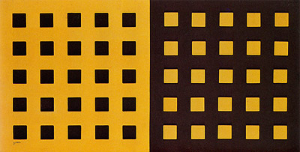Regarding the artwork [i]Concreção 5732[/i], according to Marcos Moraes, "there is an order in the organization of the parts within the whole they compose. This becomes evident in different ways in this [i]Concreção[/i], starting with the extremely high chromatic contrast of the paired surfaces. They complement each other by exploring positive-negative, full-empty, relief-cutout situations, in overlapping binary relationships, all enhancing the ambiguity of another relationship—the one between figure and background." ([i]Luiz Sacilotto[/i], [i]Coleção Folha Grandes Pintores Brasileiros[/i], Itaú Cultural).

[i]Concreção 5732, [/i]1957[br]Synthetic enamel on aluminum, c.i.e.[br]40.90 cm × 81.70 cm[br]Coleção Museu de Arte Contemporânea da Universidade de São Paulo[br]Fonte: Enciclopédia Itaú Cultural.
The artwork [i]Concreção 5732[/i] is composed of well-known geometric shapes. Identify them.
Possible answer: Squares and rectangles.
Which geometric transformation(s) can we identify in this artwork by Luiz Sacilotto?
Justify the previous answer.[br]
A square can be translated multiple times to form, for example, the entire left side of the artwork. After that, a reflection can be performed with respect to a vertical line to obtain the squares on the right side of the artwork.[br]One can also perform a homothety on one of the smaller squares to enlarge it, forming each of the larger squares.[br]The squares can be rotated 180º to generate new squares. [br]It should be noted that the justification does not consider the transformation of color change, but only the geometric transformations.
Access GeoGebra Geometry through the link [url=https://www.geogebra.org/geometry/g9f4uzcj]https://www.geogebra.org/geometry/g9f4uzcj[/url] and feel free to reinterpret the artwork using the tools you are familiar with from GeoGebra.

